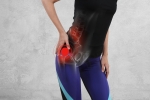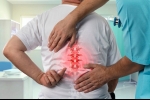Home »
Blog » Back Pain
| Stem Cell, PRP, Acupuncture in Queens & Long Island, New York
Back Pain | Stem Cell, PRP, Acupuncture in Queens & Long Island, New York
Tags: Back Pain | Posted on: 13-Jan-2021 | No of views: 5927 Significantly Reducing Lower Back, Leg, & Foot Pain. Lumbar sympathetic injections can determine if the sympathetic nerves in the lumbar (lower) spine are the cause of your pain issues. Lumbar Sympathetic Injection Facts & Information - If you are suffering from pain or weakness in your lower back, legs, or feet, you know how these symptoms can have a major impact on your quality of life. Lumbar sympathetic injections can determine if the sympathetic nerves in the lumbar, or lower, spine are the cause of your problems and treat the inflammation in order to relieve the pain.
Read more
Tags: Back Pain | Posted on: 08-Jan-2021 | No of views: 6577 Sciatica is common, affecting 10% to 40% of the population. Despite it being commonplace, many myths and misconceptions persist and, in turn, make it hard for people with sciatica to get better. Here are 10 definitive facts about sciatica to quickly get you up to speed:
1. Sciatica Overlaps with Multiple Diagnoses
2. Sciatica Refers to A Set of Symptoms
3. Level of Spinal Nerve Involvement Matters...
Read more
Tags: Back Pain | Posted on: 01-Jan-2021 | No of views: 7149 Most episodes of acute lower back pain are caused by damage to your soft tissues, such as the muscles and/or ligaments that support your lumbar spine. A common injury is a lower back strain, but it’s popularly referred to as a pulled muscle. The pain resulting from a lower back strain can be surprisingly severe, sending many patients to the emergency room.
Read more
Tags: Back Pain | Posted on: 30-Dec-2020 | No of views: 5614 Hip Joint Injections - Each year, thousands of people find that hip pain has made activities they used to welcome such as outings, exercise, and time with family/friends a chore. If you have hip pain, non-surgical treatment options should be considered first. Hip joint injections have revolutionized the treatment of hip pain and other areas affected by that pain, such as the lower back, buttock, or leg.
Read more
Tags: Back Pain | Posted on: 25-Dec-2020 | No of views: 8124 Our backs crack for myriad reasons. But what is making this sound? And when should it concern me? Read on to learn about what makes the cracking sound when you twist or bend your spine when the sound is normal, and when it may indicate a developing problem in the joints, bones, and/or muscles of your spine. The cracking, popping, or grating that you experience under your skin is called crepitus and usually originates from your joints, but may also develop within your bursae, tendons, or other soft tissues.
Read more
Tags: Back Pain | Posted on: 23-Dec-2020 | No of views: 6452 Relief from Joint Pain and Inflammation in the Neck and Back. Facts and Information - The facet joints are found in the spine, where they connect the backbones to each other. They allow the spine to bend and twist. Like a knee or hip, facet joints have cartilage between the bones and a fluid-filled capsule to allow for smooth movement. When damaged, facet joints can cause debilitating pain in the neck or back. This condition is known as Facet Syndrome. It may occur due to an injury, overuse, or the onset of an inflammatory condition.
Read more
Tags: Back Pain | Posted on: 18-Dec-2020 | No of views: 6979 A foam roller also called a styrofoam cylinder, may help you reduce pain, tender spots, and stiffness in your neck and upper back. Keep the following tips in mind when you use a foam roller to stretch your muscles or perform a self-massage. Roll Out Your Knots - Slowly roll the foam roller until you find a tender spot or trigger point. Then apply gentle, steady pressure to that spot until the pain subsides, but no longer than 60 seconds.
Read more
Tags: Back Pain | Posted on: 16-Dec-2020 | No of views: 6590 Accurate Diagnosis and Powerful Pain Relief - Epidural injections are commonly used to diagnose and treat conditions such as a herniated disc or spinal stenosis, which can cause pain in the back, leg, neck, or arm. An epidural injection may include a numbing medicine that helps determine the source of the pain and a corticosteroid medication to reduce inflammation. Physicians at National Spine & Pain Centers, with specialized training in pain management, can accurately diagnose, target, and relieve the source of your pain to help you return to an active lifestyle.
Read more
Tags: Back Pain | Posted on: 11-Dec-2020 | No of views: 8467 When red-hot sciatica pain sears down your leg, using ice therapy can be uniquely effective in immediately soothing the pain. The key is to know when and how to use ice therapy for the best results:
Use Ice Therapy as Soon as Your Pain Starts - Ice or cold therapy is recommended when your sciatica is acute or flares up. Cold therapy typically works by Increasing your tolerance to pain and slowing down the speed at which your nerves send pain signals to the brain; Acting locally, as opposed to taking oral pain-relieving medications, which have a body-wide (systemic) effect
Read more
Tags: Back Pain | Posted on: 09-Dec-2020 | No of views: 6558 Acupuncture is a complementary medical technique that has proven to be effective for chronic back, neck, shoulder, and joint pain, as well as osteoarthritis and headaches/migraines. As one of the oldest healing practices in the world, acupuncture dates back thousands of years as a form of traditional Chinese medicine. Practitioners stimulate specific points on the body—most often by inserting hair-thin needles into the skin. We combine modern technology of the West with the ancient wisdom of the East to provide you with acupuncture treatments as a natural way to relieve pain and improve your health.
Read more
Love this Post? Spread the World






















